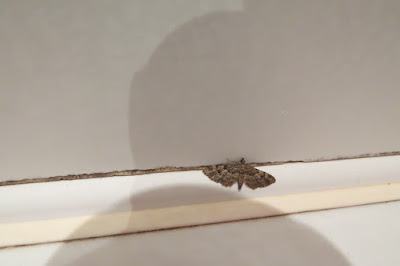Last night was exceptional for beasts. I hadn't expected anything, to the extent that I only opened the bathroom window as an afterthought.
At 11.30pm the first beast made itself known, and it was a bird! A
Tawny Owl was audible from the landing, so I shot outside and quickly located a large blob on the TV aerial across the street. The blob resumed its prolonged quivering yawl, not really a hoot. I had been half expecting the noise to be coming from a cat. Through my bins I was in time to see the owl take off and fly away over the roofs. We have heard Tawny Owl from the house before, but only a couple of times in the last 13 years, so it was definitely a bit of a coup.
Back indoors the bathroom was starting to fill up with moths. This is a slight exaggeration, but given that I still possess only two perspex pots I was going to have to be discriminating. A fruit-tree tortrix was rejected, then another one, before I spotted a little grass-veneer which looked different. I potted it. Then a medium sized macro turned up. It gained a place in the other pot. Next to appear was another biggish macro, but I could see it was a Lesser Broad-bordered Yellow Underwing, so I was able to ignore it. On the landing a pug sp had appeared. It looked interesting enough to warrant a photograph, but was later identified as a rather bright Double-striped Pug.
Later in the night a second visit caused a large geometer to arrive. I was fairly sure it was a Willow Beauty, so reluctantly released the grass-veneer in favour of the sexier beast. As luck would have it I was able to recapture the smaller moth in the morning after photographing the two macros.
So what did I get?
The first one turned out to be another one with the caveat that certain identification was not always possible without examining the genitalia. Bloody moths. Nevertheless I am pretty certain that the moth in question was a species called The Uncertain. The problem being the closely similar Rustic (not the Common Rustic which is a different species altogether).
 |
| The Uncertain Hoplodrina alsines |
The geometer was, as I had suspected, a Willow Beauty.
 |
| Willow Beauty Peritabodes rhomboidaria |
It's feathered antennae showed it to be a male.
Finally, by conveniently resting on the window frame, the grass-veneer was potted and I identified it as
Agriphila straminella.
 |
| Agriphila straminella |
Finally, the morning was to produce one more surprise, this time a bird. As I drove along Alders Drive a
Kestrel flew across the road at the island. A somewhat overdue year-tick.


















































